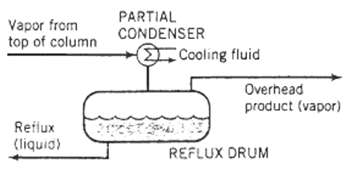The vapor leaving the top of a distillation column goes to a condenser in which either total
Question:
The vapor leaving the top of a distillation column goes to a condenser in which either total or partial condensation takes place. If a total condenser is used, a portion of the condensate is returned to the top of the column as reflux and the remaining liquid is taken off as the overhead product (or distillate). (See Problem 6.60) If a partial condenser is used, the liquid condensate is returned as reflux and the uncondensed vapor is taken off as the overhead product.
The overhead product from an n-butane?n-pentane distillation column is 96mole% butane. The temperature of the cooling fluid limits the condenser temperature to 40?C or higher.
(a) Using Raoult?s law, estimate the minimum pressure at which the condenser can operate as a partial condenser (i.e., at which it can produce liquid for reflux) and the minimum pressure at which it can operate as a total condenser. In terms of dew point and bubble point, what does each of these pressures represent for the given temperature?
(b) Suppose the condenser operates as a total condenser at 40?C, the production rate of overhead product is 75 k mol/h, and the mole ratio of reflux to overhead product is 1.5:1. Calculate the molar flow rates and compositions of the reflux stream and the vapor feed to the condenser.
(c) Suppose now that a partial condenser is used, with the reflux and overhead product in equilibrium at 40?C and the overhead product flow rate and reflux-to-overhead product ratio having the values given in part (1,). Calculate the operating pressure of the condenser and the compositions of the reflux and vapor feed to the condenser.

Step by Step Answer:

Elementary Principles of Chemical Processes
ISBN: 978-0471720638
3rd Edition
Authors: Richard M. Felder, Ronald W. Rousseau





